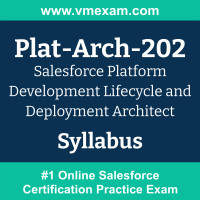 The Salesforce Plat-Arch-202 exam preparation guide is designed to provide candidates with necessary information about the Platform Development Lifecycle and Deployment Architect exam. It includes exam summary, sample questions, practice test, objectives and ways to interpret the exam objectives to enable candidates to assess the types of questions-answers that may be asked during the Salesforce Certified Platform Development Lifecycle and Deployment Architect exam.
The Salesforce Plat-Arch-202 exam preparation guide is designed to provide candidates with necessary information about the Platform Development Lifecycle and Deployment Architect exam. It includes exam summary, sample questions, practice test, objectives and ways to interpret the exam objectives to enable candidates to assess the types of questions-answers that may be asked during the Salesforce Certified Platform Development Lifecycle and Deployment Architect exam.
It is recommended for all the candidates to refer the Plat-Arch-202 objectives and sample questions provided in this preparation guide. The Salesforce Platform Development Lifecycle and Deployment Architect certification is mainly targeted to the candidates who want to build their career in Salesforce Architect domain and demonstrate their expertise. We suggest you to use practice exam listed in this cert guide to get used to with exam environment and identify the knowledge areas where you need more work prior to taking the actual Salesforce Platform Development Lifecycle and Deployment Architect exam.
Salesforce Plat-Arch-202 Exam Summary:
| Exam Name | Salesforce Platform Development Lifecycle and Deployment Architect |
| Exam Code | Plat-Arch-202 |
| Exam Price |
Registration fee: USD 400 Retake fee: USD 200 |
| Duration | 105 minutes |
| Number of Questions | 60 |
| Passing Score | 65% |
| Recommended Training / Books | Architect Journey: Development Lifecycle and Deployment |
| Schedule Exam |
Kryterion Webassessor PEARSON VUE |
| Sample Questions | Salesforce Plat-Arch-202 Sample Questions |
| Recommended Practice | Salesforce Certified Platform Development Lifecycle and Deployment Architect Practice Test |
Salesforce Platform Development Lifecycle and Deployment Architect Syllabus:
| Section | Objectives | Weight |
|---|---|---|
| Application Lifecycle Management | - Given the project risk and customer requirements, explain how to assess the benefits and risks of the different development methodologies and recommend the appropriate governance strategies based on the customer maturity. | 8% |
| Planning |
- Given a complex customer scenario, assess Application Lifecycle Management maturity and identify the people, technology, and processes required. - Understand customer environment risks and articulate appropriate mitigation strategies. - Given a customer scenario, analyze and recommend the appropriate governance framework. - Given a customer scenario involving a new Salesforce release (Summer, Winter, Spring), recommend the appropriate strategy to mitigate risks. |
13% |
| System Design |
- Explain the advantages of using agile tools to support an agile development process. - Given a customer landscape and their requirements, evaluate business, technical, and architectural considerations that support the defined org strategy. - Given a customer scenario, define an environment (sandbox) strategy that utilizes the correct sandbox types (for example, multiple project streams, training requirements, staging, production, and hotfixes). - Given a scenario, compare, contrast, and recommend the components and tools of a successful deployment strategy. |
15% |
| Building |
- Given a customer scenario, explain how to use source control branching/versioning/merging, and recommend appropriate strategies. - Describe the appropriate approaches to building test data strategy and unit test to ensure successful code (positive, negative, permission-based, large data volume). - Given a customer scenario, describe the appropriate development model (org-based vs package-based) and development environment (scratch org vs sandboxes). - Describe the methods to ensure the delivery of quality code, such as coding standards, pull requests, code review, and static code analysis. |
14% |
| Deploying |
- Given a scenario, describe the capabilities, limitations, and considerations when using the Metadata and Tooling APIs for deployment. - Given a scenario, describe approaches to handle pre and post-deployment steps, including items not supported via the APIs. - Given a scenario, describe approaches to manage and deploy technical reference data. |
14% |
| Testing |
- Given a customer scenario, describe and recommend an appropriate testing methodology. - Given a customer testing strategy, describe the appropriate test execution methodology and coverage requirements. - Given a customer scenario, describe and recommend a unified test data strategy that utilizes representative data in a secure manner throughout the development lifecycle. |
13% |
| Releasing |
- Given a scenario, analyze and explain the use cases and considerations when using managed, unmanaged, and unlocked packages. - Apply map sandbox strategy to a specific Release Plan, taking into consideration multiple project streams, training requirements, staging, and hotfixes. - Given a customer scenario, describe and recommend an appropriate release management strategy. |
13% |
| Operating |
- Given a detailed customer environment scenario including a specific request, explain the implications of incorporating the request directly in a production environment. - Given a customer scenario where changes are made directly in production, explain the implications on the development lifecycle and steps to integrate changes into Application Lifecycle Management. - Given a multi-org customer scenario, compare and contrast approaches for managing common release artifacts. |
10% |
